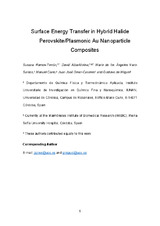Surface Energy Transfer in Hybrid Halide Perovskite/Plasmonic Au Nanoparticle Composites
Autor
Ramos-Terrón, Susana
Alba-Molina, David
Varo, M.A.
Cano, Manuel
Giner-Casares, Juan J.
Editor
Royal Society of ChemistryFecha
2021Materia
NanoparticlesPlasmonic metal nanoparticles
Photoluminescence
Perovskite solar cells
Nanometal surface energy transfer
Nanotechnology
METS:
Mostrar el registro METSPREMIS:
Mostrar el registro PREMISMetadatos
Mostrar el registro completo del ítemResumen
Incorporation of plasmonic metal nanoparticles (NPs) into the multilayered architecture of perovskite solar cells (PSCs) has been a recurrent strategy to enhance the performance of the photovoltaic devices from the early development of this technology. However, the specific photophysical interactions between the metal NPs and the hybrid halide perovskites are still not completely understood. Herein, we investigate the influence of Au NPs on the photoluminescence (PL) signal of a thin layer of the CH3NH3PbI3 hybrid perovskite. Core-shell Au@SiO2 NPs with tunable thickness of the SiO2 shell were used to adjust the interaction distance between the plasmonic NPs and the perovskite layer. A complete quenching of the PL signal in the presence of the Au NPs is measured together with a gradual recovery of the PL intensity at thicker thickness of the SiO2 shell. A nanometal surface energy transfer (NSET) model is employed to reasonably fit the experimental quenching efficiency. Thus, the energy transfer deactivation is revealed as a detrimental process occurring in the PSCs since it funnels the photon energy into the non-active excited state of the Au NPs. This work indicates that tuning the distance between the plasmonic NPs and the perovskite materials by a silica shell may be a simple and straightforward strategy for further improving the efficiency of the PSCs.

